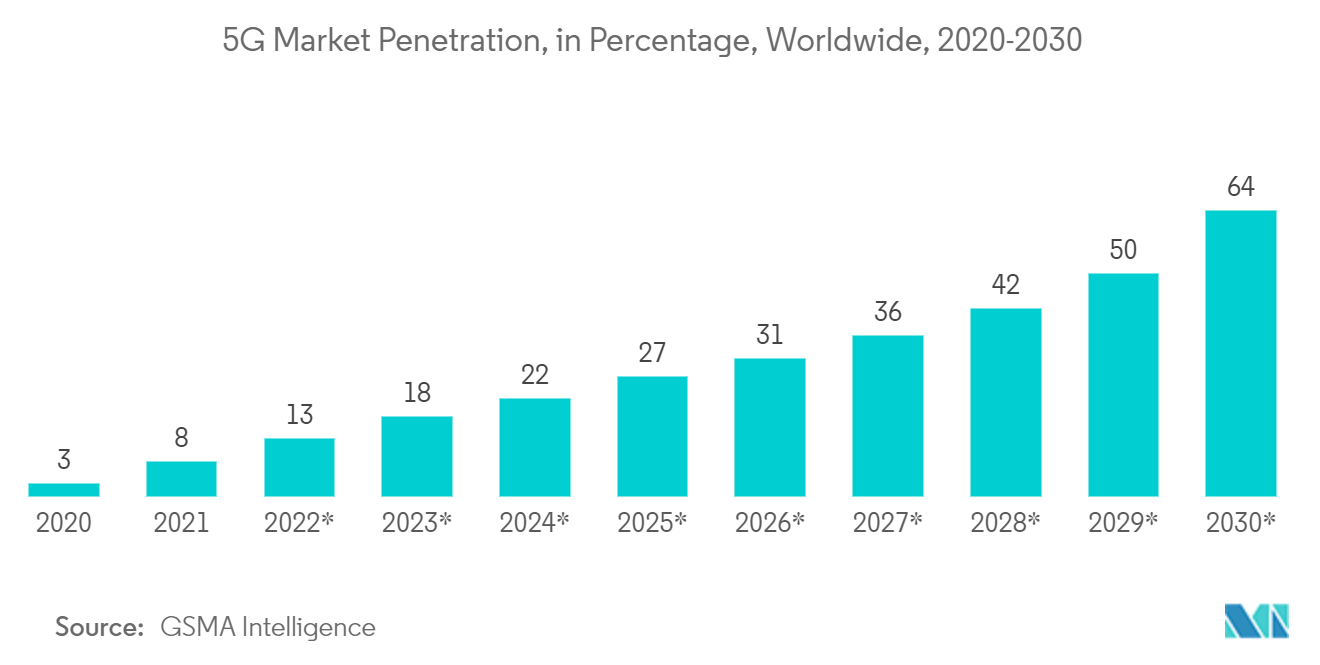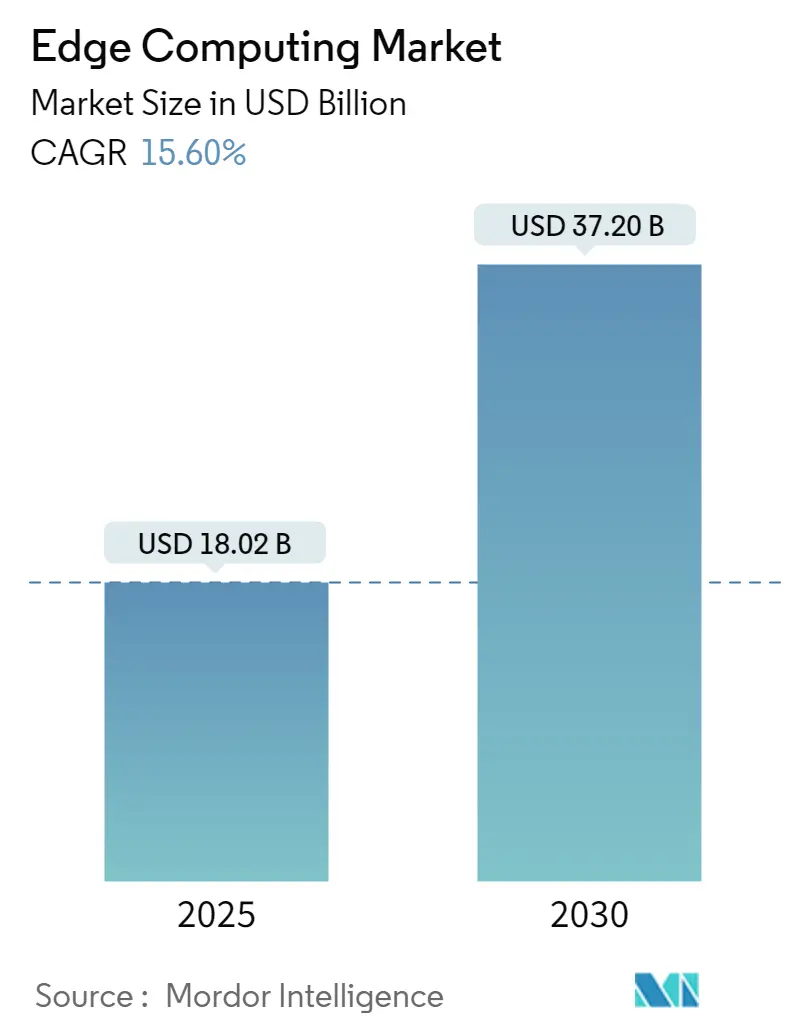
| Study Period | 2019 - 2030 |
| Market Size (2025) | USD 18.02 Billion |
| Market Size (2030) | USD 37.20 Billion |
| CAGR (2025 - 2030) | 15.60 % |
| Fastest Growing Market | Asia Pacific |
| Largest Market | North America |
| Market Concentration | Low |
Major Players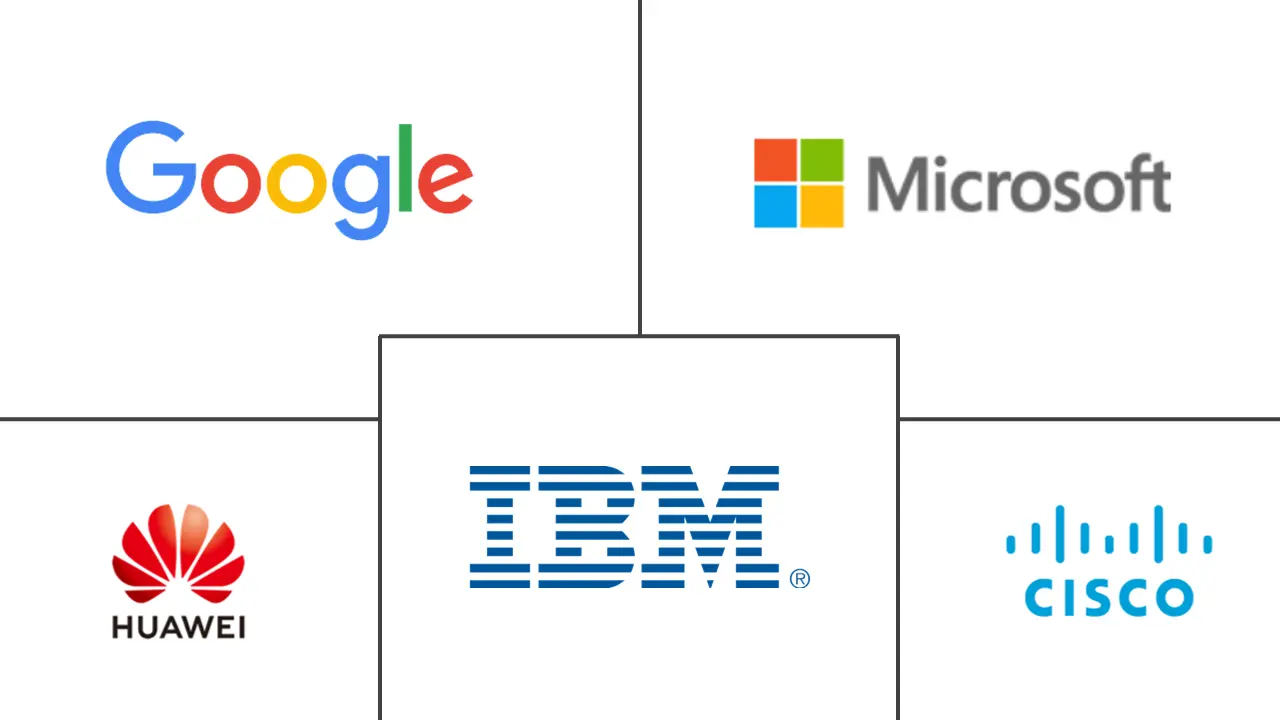
*Disclaimer: Major Players sorted in no particular order |
Edge Computing Market Analysis
The Edge Computing Market size is estimated at USD 18.02 billion in 2025, and is expected to reach USD 37.20 billion by 2030, at a CAGR of 15.6% during the forecast period (2025-2030).
The increasing adoption of IoT is augmented by 5G operations, primarily driving the growth of the market studied. A significant share of industrial IoT service providers and aggregators are offering 5G capable network offerings that are expected to adopt edge computing over the coming years for handling the sheer amount of data.
- The key players that are significantly active in the market studied include cisco, HPE, Dell, and Huawei. They have been developing edge computing products that adapt to harsh working conditions and operating environments at industrial sites, such as anti-electromagnetic interference, anti-dust, anti-explosion, anti-vibration, and anti-current/voltage fluctuations. These companies are making significant efforts in the edge computing market to create the next big thing by engaging in partnerships and making frequent product developments.
- Edge computing is being led by initiatives like OpenFog Consortium, an organization headed by vendors in the market studied, including Cisco, Intel, Microsoft, and Dell EMC, as well as academic institutions like Princeton University and Purdue University. The consortium aims at developing reference architectures for fog and edge computing deployments.
- In January 2022, Verizon and AWS partnered to expand to 30% more metro area locations in the United States with mobile edge computing with the addition of Charlotte, Detroit, Los Angeles, and Minneapolis. The combination minimizes the latency and network hops required to connect from an application hosted on the platform to the end user's device.
- The edge computing market is dominated by major vendors that cover a significant share of the market studied, and they are intensely competing to gain a foothold in different regional markets. Owing to this, vendors are involved in several partnerships and alliances to gain market presence and technological capabilities.
- For instance, In April 2022, Ball extended its agreement with AWS. This collaboration aims to launch the first public multi-access edge computing (MEC) with AWS Wavelength in Canada. 5G network is expected to bring new growth opportunities to the edge computing market.
- The COVID-19 pandemic positively affects the 5G and multi-access edge computing (MEC) deployments as businesses strategize service speed and low latency as key differentiators. The tight integration of network and compute to support next-generation apps is the way forward.
Edge Computing Market Trends
Telecommunication Sector is Expected to Grow at A significant CAGR
- Telecommunications is one of the fastest evolving industries in the global market. The industry is currently in the process of upgrading its infrastructure to prepare for the 5G transition coupled with the booming 5G penetration across the world, is driving the telecom sector to invest in edge computing resources.
- Edge computing is poised to significantly reshape telecom networks, driven by 5G and the IoT. Additionally, the dependence on the cloud, the reliance on internet connectivity, and the enormous growth and potential of the IoT are some of the critical factors driving telecoms toward the edge. Telecom operators can use edge both to boost their core connectivity business and reduce latency for their own customers, as well as to introduce new services such as data management at the edge.
- Further, as 5G technologies become more regulated and go mainstream, 5G-compliant devices are expected to grow, leading to several capacity issues. Although the mm-wave bands ensure that they are highly differentiated from the 3G or 4G bands, the increased number of subscriptions is likely to create demand for additional computing resources at the edge.For instance, according to the data from GSMA Intelligence, the 5G market penetration worldwide is expected to increase from 3% in 2020 to 64% in 2030.
- The combination of 5G, IoT, and edge computing would be transformational for both communication service providers and their customers. Edge computing technology has become the major area of investment in the telecom industry, driven by CSPs' need to enhance user experiences and enable and support new business models. CSPs are investing in edge computing technology to meet the growing demand.
- Owing to such potential demand in the global market, several open-source architectures are emerging. Initiatives by The Open Networking Foundation, Akraino Edge Stack project, and others, are expected to accelerate the demand for edge computing in the sector.
Asia Pacific is Expected to Grow at a Highest CAGR
- China has made a good start in terms of 5G and the edge; a surveillance culture could set the course for the evolution of technology. Western companies such as Meta, Apple, Netflix, and Google have shaped the global digital economy by establishing standards for using personal data to target ads. Chinese companies such as Alibaba, Baidu, Huawei, and ZTE are shaping the future direction of edge computing-backed surveillance technology. Such initiatives in China cater to the demand; thus, the country has the highest share in the region.
- According to a survey by GSMA, approximately 90% of mobile ecosystem players in China recognized edge computing as a significant revenue opportunity in the 5G era. The country's edge computing deployments are designed to meet smart ports, campuses, and factories' requirements. As the 5G networks scale over the next few years, edge computing use cases, such as sporting events, gaming, and autonomous driving, will be possible.
- IIJ deployed MDC on the premises of Shiroi Data Center Campus (Shiroi DCC). The MDC, from Australian manufacturer Zella DC, was the first to be installed in Japan. It is equipped with the functions a data center needs, including a cooling unit, an uninterruptible power supply (UPS), environmental sensors, security cameras, and physical security, including a remote-controlled electronic lock.
- As part of the Digital India initiative, the Government of India planned to give IoT a push in the country. The government has allocated INR 7,000-crore funds to develop 100 smart cities powered by IoT devices. The government intends to control traffic, efficiently use water and power, and collect data using IoT sensors for healthcare and other services.
- In February 2022, Reliance Jio enabled edge computing on its cloud-native 5G network at more than 50 facilities across India. The telco has completed 5G planning for the "top 1,000 cities" across India, and dedicated teams have been formed to focus on "dedicated solutions for 5G deployment" in the country. Jio, Airtel, and Vodafone Idea are currently piloting innovative 5G use cases with their equipment and enterprise partners using the trial 5G spectrum.
- Moreover, in March 2022, Tata Consultancy Services announced the launch of an enterprise 5G edge solution suite with Microsoft Azure Private Mobile Edge Computing (Private MEC). Such developments are poised to grow the demand for edge computing in the Asia Pacific region over the forecast period.
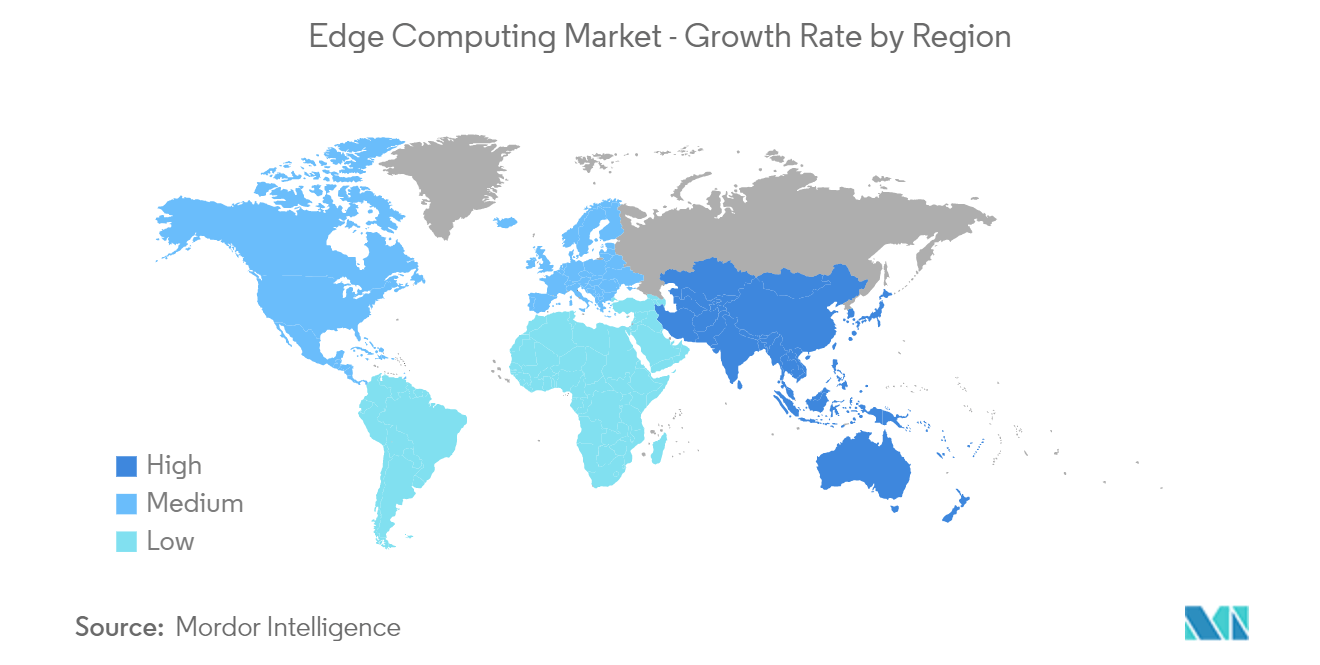
Edge Computing Industry Overview
The edge computing market is fragmented and competitive in nature. Currently, the market is dominated by cloud-based IoT vendors, such as Dell, Microsoft, Amazon, and Google. Companies like GE, which have the expertise of delivering edge computing solutions across different industries, including aerospace or manufacturing, also have significant market positions. Acquisitions, partnerships with industry participants, and new product/service rollouts have been the vendors' key competitive strategies. Some of the recent developments in the market are:
- April 2022 - Dell Technologies expanded its edge solutions to help retailers quickly generate more value and deliver enhanced customer experiences from data generated in retail locations.
- March 2022 - Huawei and Du signed a memorandum of understanding (MoU) for joint innovation on multiaccess edge computing (MEC). The two companies would research, verify, and replicate MEC-oriented applications in the Middle East. The companies also aim to accelerate digital transformation in the Middle East, along with supporting the development of the global digital economy.
- March 2022 - FogHorn collaborated with IBM to provide a secure and open next-generation hybrid cloud platform with advanced, closed-loop system control capabilities and edge-powered artificial intelligence (AI). By bringing together edge and cloud capabilities, FogHorn and IBM plan to help customers rapidly process, deploy, analyze, store, and train critical data from the edge to the cloud and enhance their business processes.
Edge Computing Market Leaders
-
Microsoft Corporation
-
Google LLC
-
IBM Corporation
-
Huawei Technologies Co. Limited
-
Cisco Systems Inc.
- *Disclaimer: Major Players sorted in no particular order
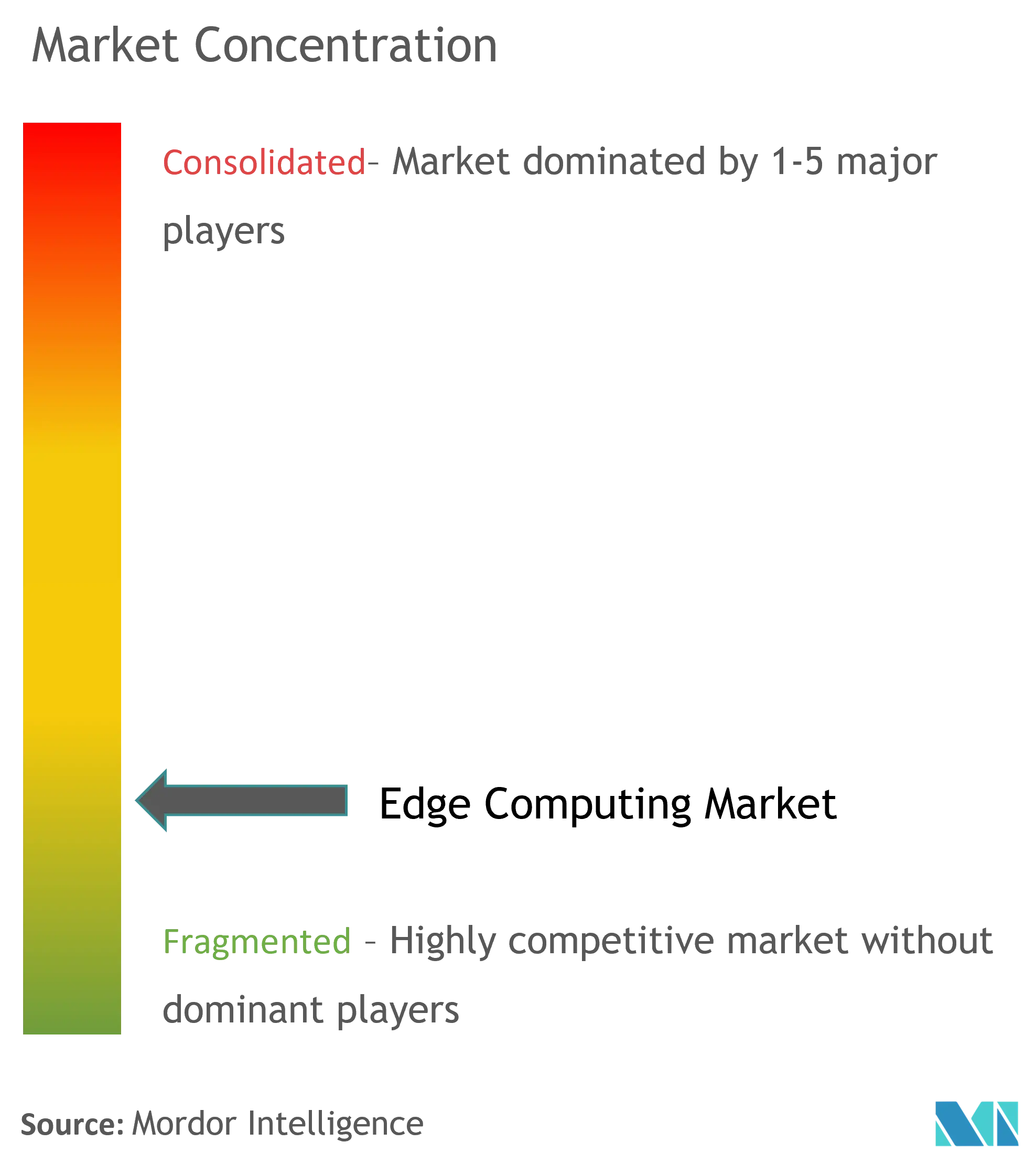
Edge Computing Market News
- July 2022 - Lumen Technologies is expanding its Edge Computing Solutions into Europe and investing in its global Edge network, giving businesses the low latency platform to extend their high-bandwidth, data-intensive applications out to the cloud edge. This expansion is part of Lumen's ongoing commitment to next-generation solutions that revolutionize digital experiences and meet the requirements of today's global businesses.
- May 2022 - 5TONIC, the open research and innovation laboratory focused on 5G technologies, founded by Telefónica and IMDEA Networks, took a step toward network as a service by integrating the 5G SA network and a multiaccess edge computing platform with Ericsson, Intel, Telefónica, DeepSight, and Capgemini Engineering.
- March 2022 - ADLINK Technology Inc. and AUO, leading providers of optoelectronic solutions, announced that they would be hosting their first joint virtual technology forum for the EMEA region.
Edge Computing Industry Segmentation
Edge computing refers to the distributed computing paradigm, mainly used to bring computing and data storage closer to the location to improve the response time. The analysis tools used across industries are beginning to drive new levels of performance and productivity. Therefore, the distributed computing paradigm called edge computing is gaining traction.
The Edge Computing Market is Segmented by Component (Hardware, Software, and Services), End User (Financial and Banking Industry, Retail, Healthcare and Life Sciences, Industrial, Energy and Utilities, Telecommunications), and Geography (North America, Europe, Asia Pacific, Latin America, Middle East & Africa).
The market sizes and forecasts are provided in terms of value (USD Billion) for all the above segments.
| By Component | Hardware | ||
| Software | |||
| Services | |||
| By End-user | Financial and Banking Industry | ||
| Retail | |||
| Healthcare and Life Sciences | |||
| Industrial | |||
| Energy and Utilities | |||
| Telecommunications | |||
| Other End-users | |||
| By Geography | North America | United States | |
| Canada | |||
| Europe | United Kingdom | ||
| Germany | |||
| France | |||
| Rest of Europe | |||
| Asia Pacific | China | ||
| Japan | |||
| Australia | |||
| Rest of Asia Pacific | |||
| Latin America | Mexico | ||
| Brazil | |||
| Rest of Latin America | |||
| Middle East and Africa | United Arab Emirates | ||
| Saudi Arabia | |||
| Rest of Middle East and Africa | |||
Edge Computing Market Research FAQs
How big is the Edge Computing Market?
The Edge Computing Market size is expected to reach USD 18.02 billion in 2025 and grow at a CAGR of 15.60% to reach USD 37.20 billion by 2030.
What is the current Edge Computing Market size?
In 2025, the Edge Computing Market size is expected to reach USD 18.02 billion.
Who are the key players in Edge Computing Market?
Microsoft Corporation, Google LLC, IBM Corporation, Huawei Technologies Co. Limited and Cisco Systems Inc. are the major companies operating in the Edge Computing Market.
Which is the fastest growing region in Edge Computing Market?
Asia Pacific is estimated to grow at the highest CAGR over the forecast period (2025-2030).
Which region has the biggest share in Edge Computing Market?
In 2025, the North America accounts for the largest market share in Edge Computing Market.
What years does this Edge Computing Market cover, and what was the market size in 2024?
In 2024, the Edge Computing Market size was estimated at USD 15.21 billion. The report covers the Edge Computing Market historical market size for years: 2019, 2020, 2021, 2022, 2023 and 2024. The report also forecasts the Edge Computing Market size for years: 2025, 2026, 2027, 2028, 2029 and 2030.
Our Best Selling Reports
Edge Computing Industry Report
The global edge computing market is on a trajectory of significant growth, fueled by the escalating demand for efficient data processing and analysis across diverse sectors. The advent of IoT, AI, and 5G technologies has led to a surge in data volume necessitating real-time processing. Edge computing emerges as a pivotal solution, offering reduced latency, improved bandwidth, and enhanced security, making it appealing for telecommunications, healthcare, manufacturing, and transportation industries. This market, characterized by innovation and a competitive landscape, sees accelerated adoption due to smart cities, industrial automation, and autonomous vehicles, despite facing challenges like initial capital expenditure and cybersecurity concerns. According to Mordor Intelligence™ Industry Reports, the edge computing market is set for substantial expansion, highlighting its evolving digital technologies and the increasing need for efficient data processing capabilities across various sectors. Access a free report PDF download for a detailed industry analysis and market forecast outlook.



